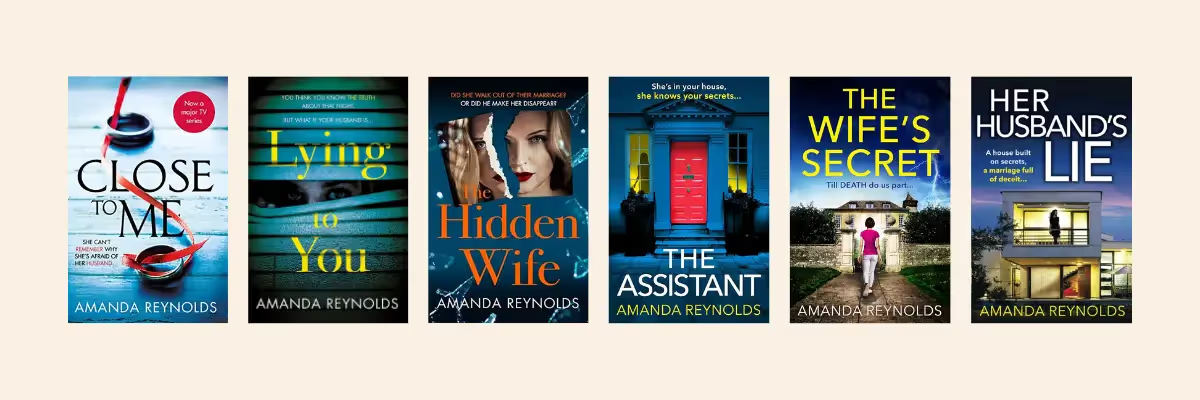When we start planning a novel, we usually start with our protagonist: the hero of the story, to whom the most change occurs. But beyond this point, you might find yourself wondering whether your novel needs an antagonist. But what is an antagonist?
In this article, writing coach Amanda Reynolds clarifies exactly what an antagonist is, provides examples from popular fiction, and demonstrates the ways you can incorporate an antagonist into non-human aspects of your narrative.

Amanda Reynolds is the author of six bestselling psychological suspense novels. Her number-one bestseller, Close To Me, was developed into a major TV series featuring Connie Nielsen and Christopher Eccleston. She coaches mystery, psychological suspense, and thriller at The Novelry and knows all too well how important an antagonist is in maximizing a novel’s conflict and tension—so, over to Amanda.
What is an antagonist?
The first thing that often comes to mind when we think of an antagonist is the archetypal ‘bad guy.’ The James Bond villains who have dastardly plans to take over the world. It’s 007’s job to foil them, a quest we follow, rooting for James—an exciting, action-packed journey.
But antagonists come in many shapes and forms.
An antagonist is anything that gets in the way of our protagonist’s goal, providing conflicts between the protagonist and antagonist as they have diametrically opposing motivations. This division provokes not only conflict but change, ensuring plenty of action and character development along the way.

Without an antagonist, there would be no story.
No conflict → No change → No story.
The presence of an antagonist enhances the drama of a story by challenging the protagonist.
But an antagonist doesn’t have to come in the form of an evil genius stroking a white cat. Of course they don’t. They don’t even have to be human.
Any forces opposing the protagonist’s goal are classed as antagonistic and using those to the maximum effect will improve a story immeasurably, ensuring a fulfilling, pacy plot with well-developed character arcs and a struggle that seems impossible to overcome.
The more rocks we throw at our protagonists, the more persuasive their struggle will be, with multiple problems and obstacles coming at them from every direction.

Forces rather than individuals
Clare Mackintosh, one of our bestselling writing coaches here at The Novelry, says:
I encourage writers to view antagonists as ‘external forces’ rather than individuals (there can be a lot of crossover with ‘obstacles,’ depending on the story, but I don’t think that’s a bad thing). These antagonists come in many forms, from the natural world, societal pressure, tech and infrastructure, and fate and the supernatural.
—Clare Mackintosh
Antagonist as setting
Antagonist as setting is a classic storytelling technique. Think of the speeding train in Murder on the Orient Express, the dystopian world of The Handmaid’s Tale, or the brutal prison environment of The Silence of the Lambs.
From the snowy world of The Lion, the Witch and the Wardrobe to the claustrophobia of Manderley in Rebecca, each of these settings presses in on the characters, limiting their options and pushing them into making extreme choices to achieve their aims.
.avif)
Melanie Conklin, a writing coach for children’s and YA fiction here at The Novelry, says:
My favorite antagonist is the setting. I always try to situate my story at a time and place that maximizes the conflict for my main character. A setting that works for your character makes their life easier. A setting that is an antagonist makes their journey even harder and much more interesting to follow. Think Mordor in The Lord of the Rings. If it had been close to the Shire and easy to access, Tolkien wouldn’t have had such a captivating story to share with us.
Man versus nature. Man versus man. Man versus self.
—Melanie Conklin
Antagonist as society
Often found in literary and historical fiction, the external forces at work in these stories are also representative of the character’s place in their world, with the accompanying economic and societal pressures of the time—the more limited role of women, for instance, or cultural norms and expectations, even etiquette.
In The Remains of the Day by Kazuo Ishiguro, the yearning to break out, to say something, is prevalent throughout; the British class system and the servitude of those working for an aging aristocracy are evoked through a thwarted love story filled with regret. If that societal pressure weren’t deep-rooted in the characters, it would not be the same story.

As Mahsuda Snaith, another writing coach here at The Novelry, explains:
In literary fiction, writers often have the antagonist as the external force of ‘society’ and sometimes this is so vague it’s hard to see that there is an antagonist. If this is the case, I usually advise that society is shown through representatives in the book, such as an overly officious bureaucrat or the judgmental neighbor.
—Mahsuda Snaith
By embodying the antagonist in a specific character, it becomes much clearer what pressures are at work.
Antagonist as self
Sometimes, though, the only person holding back a character is themselves.
In A Man Called Ove by Fredrik Backman, our protagonist becomes his own antagonist, refusing to accept help although he so clearly needs it. When friendship and human connection are thrust upon him, it’s a challenge he resists, making life as difficult for himself as he possibly can. He has his reasons, of course: protection, fear, and grief. Self-sabotage is a common internal force. What we think we want gets in the way of what we actually need.
Ove is an extreme example, but building walls around a character that they or others need to break down will incorporate another antagonistic force into the story. As authors, we have to make life as difficult as possible for our characters. The arrival of joy is even sweeter for the struggle to get there.

Antagonists in romance
A classic example of this is in romance, as one of our editors here at The Novelry, Nic Caws, explains:
Enemies-to-lovers storylines do this all the time. So the antagonist seems like the ‘bad guy/gal’ on the surface because their goals are in opposition to the protagonist’s, but they really have excellent motivations and a heart of gold, such as in Love, Theoretically by Ali Hazelwood.
—Nic Caws
{{blog-banner-5="/blog-banners"}}
Antagonist as supernatural
The supernatural, often malevolent antagonist, such as Voldemort in Harry Potter, represents the struggle of good over bad, right over wrong. These antagonists must be destroyed at all costs, and the protagonist is the chosen one for a reason. It may seem like an impossible task, with ridiculous odds stacked against them, but in the end, good will prevail over evil. We hope...
%2520(2).avif)
Antagonist as secrets
In my genre, psychological suspense, the external forces working against the protagonist are often built around a secret that must be exposed/unraveled before the main character can move past this huge obstacle and toward their future happiness. There are numerous examples of antagonists in literature, such as the letter in Liane Moriarty’s My Husband’s Secret or the web of lies left in a missing husband’s wake in my latest book, Her Husband’s Lie.
Whether the threat is real or perceived, there are external forces working against the protagonist that they have to find a way through. Often, these external forces are then embodied in an antagonist that takes away everything they trusted and believed in, even their belief in themselves.
In my debut, Close To Me, a head injury causes Jo, my protagonist, to lose a year of memories. It may or may not have been an accidental fall, but the loss of recall becomes Jo’s antagonist as she battles her brain injury to try to get to the truth of what that lost year held.
Whatever form of antagonist our heroes and heroines encounter—external forces imposed by the natural world, oppressive regimes, societal pressure, or maybe all of these—it’s up to us as authors to push our protagonists to the extreme because that’s when we learn what they are made of, what they truly desire, and how far they will go to get it.
Welcome home, writers. Join us on the world’s best creative writing courses to create, write, and complete your book. Sign up and start today.
.avif)


.avif)
.avif)

.avif)